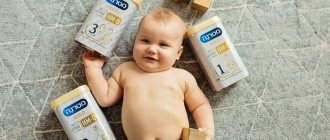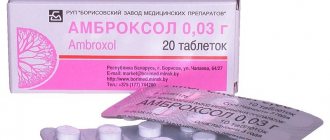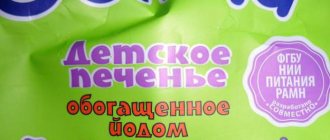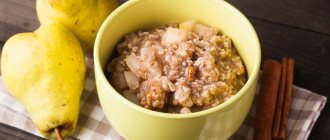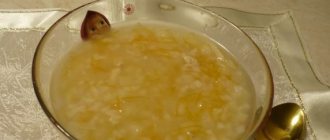Porridge is an integral part of the diet of a one-year-old child. A properly prepared dish of different grains can become a valuable source of fiber and complex carbohydrates for the whole day. Porridge for breakfast brings a feeling of fullness and charges the baby with energy for new achievements. Pediatricians emphasize that not all cereals have a beneficial effect on the still fragile body of a one-year-old child. Therefore, our magazine decided to figure out what porridges should be present in the diet of a 1-year-old child and how to cook cereals correctly so that the baby does not turn away from the proposed dish, but eats porridge with pleasure. recipes for delicious porridges for your little ones below.
What cereals are good for children?
All cereals are healthy in their own way. The best porridges in a child's diet are oatmeal and buckwheat.
Oatmeal is rich in vitamins A and E, as well as groups of vitamins B, C and PP, enzymes that promote the breakdown of fat in the intestines.
Buckwheat porridge is rich in calcium, necessary for the growth and strengthening of bones, and iron for the normal functioning of the hematopoietic organs.
The erroneous opinion of our mothers and grandmothers is that semolina porridge is the healthiest. It is made from wheat grains that do not contain the germ and shell, which makes it practically empty, devoid of essential nutrients, but rich in protein and starch.
Semolina porridge should not be given to overweight children. Liquid semolina porridge for a child aged 6 months or older is prepared according to the following recipe: pour half a glass of water into a saucepan, bring to a boil, add 2 tablespoons of sifted semolina and stir constantly for 10–15 minutes. Then add half a glass of milk and bring to a boil. Sometimes salt and sugar are added to semolina porridge, but for up to one year you can do without them when preparing.
The healthiest porridges for children: the amazing seven, in which there was no place for semolina porridge
Porridge for a child is one of the main dishes of the daily diet, starting from the first feeding stage. And for sure, being a loving and caring parent, you feed your child porridge every day. Do you know which cereals are most beneficial for children?
Porridge is a very “important” food for growing organisms. All that remains is to figure out which cereals are really healthy for children, and which ones can be safely removed from the children’s diet.
What is porridge and what is it eaten with?
So, porridge, with rare exceptions, is a dish made from boiled grains (that is, from cereals). There are dozens of different types of cereals, and not all of them are useful for baby food.
Moreover, it turns out that the usefulness of baby porridge can vary significantly depending on what exactly the grains were cooked in.
For example: it is well known that buckwheat porridge is an extremely healthy dish, both in the diet of adults and for children. And all thanks to the fact that buckwheat is surprisingly rich in iron.
It is so rich that regular consumption of buckwheat porridge by a child can be considered a worthy prevention of childhood anemia...
However, all the benefits of buckwheat porridge will instantly disappear as soon as you add milk to it (and this is exactly what 90% of mothers do).
The bottom line is that iron is not absorbed by the body in the presence of calcium, which, as you know, is invisible in milk.
So it turns out that buckwheat boiled in water turns into one of the healthiest porridges for children, while buckwheat boiled in milk loses all its potential benefits.
Porridges are so healthy for children that experts advise introducing them into complementary foods from the first year of a baby’s life...
What porridges are most useful for children?
Nutritionists around the world have conducted dozens of studies in search of answers to the question of which cereals are most beneficial for children. More precisely, not so much porridge as cereal - after all, from the same cereal, a skillful and efficient mother can prepare not only porridge, but also many other dishes (for example, cookies, homemade granola, casseroles, side dishes, cutlets and even soups).
So, as a result of numerous and thorny studies, nutritionists and pediatricians have identified the 7 most beneficial cereals for children. The following three “winners” took the podium:
- 1 Buckwheat porridge with water. Surprisingly, buckwheat cannot be called a world-famous and popular cereal in the world - in many countries they have not heard of it at all. Meanwhile, buckwheat porridge is considered the most useful for children. It contains a lot of iron (but remember, it will lose its valuable properties as soon as you combine buckwheat with milk), as well as a lot of valuable protein, easily absorbed by the child’s body.
- 2 Oatmeal. The benefits of oatmeal for children, or vice versa - its completely useless use, directly depends on how the oatmeal is processed. For example, such a common product on the shelves of our supermarkets as “instant oatmeal” - porridge that you just need to pour boiling water over before eating - no self-respecting nutritionist would call a healthy dish, neither for adults, nor even less for children. Healthy oatmeal for children is flakes (like the well-known “Hercules”), which require cooking for 3 or more minutes.
Oatmeal for children is a source of dietary fiber, vitamins and minerals. In addition, some experts believe that gluten, which properly cooked oatmeal is so rich in, helps remove harmful toxins from the body (a very useful quality for residents of large cities)…
- 3 Pearl barley porridge. But this is a surprise, you must agree! Indeed, the third place among the healthiest porridges for children was taken by pearl barley - an undeservedly forgotten dish made from barley. Like buckwheat porridge, barley is rich in both protein and iron. On the other hand, it contains no less valuable fiber than oatmeal.
No wonder pearl barley was the favorite porridge of Roman gladiators! Nutritionists have confirmed that properly prepared pearl barley is a super healthy dish for a healthy diet for both adults and children. The main thing is not to give in to the temptation to buy “instant” porridge! “Real” healthy pearl barley porridge takes a long time to prepare (often the cereal is pre-soaked) - but it is definitely worth the effort!
But you won’t go far with the three healthiest cereals for children and you won’t be able to create a complete diet. Therefore, we suggest adding to the list a few more healthy cereals for children, which will not only diversify, but also decorate your everyday family menu. So, healthy cereals also include:
Millet porridge. The “progenitor” of millet is millet, rich in protein, fiber, as well as such valuable elements as iodine, magnesium, chromium, iron and others.
Millet porridge improves the functioning of the gastrointestinal tract, accelerates the process of hematopoiesis (millet porridge is often prescribed to the diet of children with anemia), moreover, millet has the amazing property of removing antibiotic residues from the body.
So, with any antibacterial therapy, millet porridge for children is the best and healthiest breakfast.
Corn porridge (aka maize porridge). It has earned an honorable place in the seven healthiest porridges for children due to its balanced content of proteins, fats and carbohydrates, and its ability to normalize the functioning of the gastrointestinal tract. Glutamic acid, which is part of the chemical composition of maize, naturally enhances brain activity in a child.
Rice porrige. As in the case of oatmeal, the method of processing rice and its variety directly determine the usefulness of the porridge. For example, white, polished, peeled rice is practically useless for our body. While brown and unpolished rice is the richest source of dietary fiber, a storehouse of macro- and micronutrients, and an excellent supply of protein.
Flaxseed porridge (from flaxseed). A long-forgotten and in our time still little popular dish of Russian cuisine. At the same time, it is incredibly useful, especially for a growing child’s body.
At least because flax is one of the rare plants that contains omega-3 and omega-6 fatty acids (the same ones that parents “push” into their children in the form of fish oil).
Surprisingly, flax seeds contain 3 times more of these fatty acids than fish!
Semolina porridge is by no means manna from heaven...
And where does semolina porridge rank in terms of usefulness?, you ask. After all, it is precisely this – semolina porridge – that is one of the most persistent and widespread memories of childhood as such among us, Russians.
And our mothers, and our grandmothers, and cooks in children's institutions - all as one for many years convinced us to eat “the healthiest semolina porridge” - a spoonful for all relatives right up to the seventh generation...
It is, of course, difficult to resist the Soviet tradition, but it will be necessary: modern nutritionists have proven that semolina porridge not only falls short of the list of the most healthy cereals for children, but rather, on the contrary, tops the rating of the most useless dishes in the children's diet.
Semolina porridge, in fact, is nothing but carbohydrates.
For the hungry post-war period or during periods of terrible food shortages, of course, semolina porridge was a kind of manna from heaven: it nourished the body extremely poorly, but satiated for a long time, was cheap to produce and was suitable for feeding absolutely everyone - from still toothless babies to already toothless old people.
So, if your task is to save a child from hunger, then semolina porridge is quite suitable for this purpose.
However, for the full growth and development of a growing organism, not only energy is needed (which is provided by carbohydrates), but also a whole set of certain substances - fiber, vitamins, micro- and macroelements, etc.
But, alas, there is none of the above in semolina... Just as there is none in instant oatmeal, in polished white rice, or in “semi-digested” barley.
Healthy cereals for children exist, and there are quite a few of them! And now you know exactly what kind of cereals you should have in your home in order to prepare useful, healthy and varied cereals from them not only for children, but for the whole family.
Source: //www.woman.ru/kids/feeding/article/82526/
Porridge as a first food
Along with vegetable purees, porridge can be used as a first complementary food. It is especially recommended to give porridge to children with reduced body weight or weakened immunity. According to the recommendations of the World Health Organization, breastfed children should be given porridge no earlier than 6 months. As for children fed infant formula, from 4–5 months, porridge is perfect as a first complementary food and an additional source of elements necessary for growth and development.
Baby porridge - general principles and methods of preparation
Baby cereals are introduced into a child’s diet as complementary foods from 7-10 months. After all, it’s time for the baby to receive more complete and balanced nutrition. You can buy special instant baby cereals, but you cannot give “quick” cereals, such as muesli, with various fillings. They are not adapted for the stomach of a small child; they contain dyes, flavor enhancers and other food substitutes. What can cause allergies or stomach upset in your baby? It is best to prepare porridge yourself from natural cereals. And you can start with rice. This cereal does not contain gluten, is completely hypoallergenic, and does not irritate the intestines at all. And then gradually you can introduce porridges from other cereals into the menu. For children under one year old, porridge with a liquid consistency is cooked.
Milk porridge for children
Parents most often face the question of how to prepare porridge for a one-year-old child - with water or milk? Definitely, porridges cooked with milk are healthier than those cooked with water. They are tastier and higher in calories. But milk porridges are contraindicated for children with intolerance to cow's milk protein or a tendency to allergies. Recipes for milk porridges are passed down from generation to generation and remain virtually unchanged.
Milk porridge for one-year-old children can no longer be cooked from ground cereal, but from whole grain. After all, by the age of one year, children begin to need chewing movements.
Milk oatmeal for children. The recipe for this porridge is very simple: to 120 ml of milk (almost half a glass), add 40 ml of drinking or boiled cooled water, a quarter teaspoon of sugar, all this is poured into a saucepan and brought to a boil over low heat. As soon as the liquid begins to rise, you need to add 2 tablespoons of oatmeal and stir constantly for 7 minutes. You can put a small piece of butter in the finished porridge. If the child refuses to eat, then the porridge can be decorated with a spoonful of jam and a few fresh berries.
To prepare milk buckwheat porridge, add 3 tablespoons of buckwheat to 1.5 cups of boiling water (sort and rinse in advance), cook for 40 minutes. 5 minutes before readiness, add a glass of milk and stir. When the porridge is ready, let it sit on the table for another 20 minutes under the lid, stirring occasionally. Add a piece of butter to the finished porridge.
Dear readers, in this article we will look at how to cook buckwheat porridge for a baby. You will learn different recipes for preparing this dish. Find out how to cook for babies, what is the recipe for a dairy dish, and familiarize yourself with the method of cooking in a slow cooker.
Baby cereals - food preparation
If you are preparing dishes for children, then the processing and preparation of products should be approached with special care. All cereals, except semolina, are sorted, i.e. inspected visually to prevent the ingress of foreign small objects, and then washed several times. If the dish includes vegetables or fruits, they must be thoroughly rinsed under water and peeled. And then, according to the recipe, they are cut into pieces or grated.
If there is a small child in the house, it is advisable to immediately buy a measuring cup with divisions so that it is convenient to measure the amount of cereal or liquid. For children under one year old, whole grains of any cereal must be ground to flour, and then the porridge should be cooked. It is convenient to use a coffee grinder for this. If there is no coffee grinder, then the finished porridge is rubbed through a sieve or ground with a blender and diluted to the desired consistency with water or infant formula (breast milk).
Baby porridge - the best recipes
The value of cereals
There are 110 kilocalories per 100 g of cooked porridge.
- Protein of plant origin is easily absorbed by the child’s body and actively stimulates the formation of muscle mass.
- Buckwheat contains a balanced composition of amino acids.
- The fiber contained in cereals affects the normalization of digestion and improves intestinal motility.
- The complex carbohydrates contained in buckwheat help you feel full. During the breakdown of these biologically active substances, energy is released.
My son has been very fond of eating buckwheat porridge since childhood. As I grew older, I began to prefer buckwheat with meat. Today he is completely indifferent to this cereal and prefers oatmeal.
Recipe 3: Oatmeal with banana for children
To prevent oatmeal from becoming boring, you can serve it with jam, honey or various fruits - banana, grated strawberries, or apple.
Ingredients : 3 tbsp oatmeal, glass of milk, ½ banana, salt, 1 tsp. Sahara.
Cooking method:
Boil milk (you can dilute it with water), add sugar, a pinch of salt, add oatmeal. Turn the heat to low and cook for half an hour. Allow the finished oatmeal to cool slightly, add the chopped banana and blend with a blender.
Cooking features
- If you are preparing porridge for an infant, then do not rush to add butter, sugar, as well as salt and milk.
- A child at seven months can already prepare a dairy dish, but only by diluting it with water and only when there is no allergy to this product.
- A child of 1 year old no longer has to grind buckwheat before cooking. The exception is the absence of chewing teeth.
- If you are preparing porridge with a liquid consistency, you can offer your baby to eat it from a bottle. But, if the little one already knows how to eat from a spoon, then it is better not to use a bottle.
What are the benefits of cereals?
Cereals are a valuable food product that is a source of complex carbohydrates. Products in this group are a source of energy and also give you a feeling of satiety. Cereals also contain proteins, fats and carbohydrates, along with vitamins and minerals. There are a lot of microelements in cereals, such as calcium, magnesium or iron.
Each type of cereal has its own benefits and characteristics. For example, buckwheat is considered the most valuable due to the absence of gluten and high content of proteins, fats, iodine, iron and other microelements. In the group of gluten-free cereals, rice and corn occupy an important place. Rice contains beneficial components to a lesser extent, but serves as an excellent nutritional component of the diet and is well absorbed by the intestines. Corn grits are healthier, they contain components useful for the structure of the body, they are as easily digestible as rice, but they take a long time to cook.
Oatmeal ranks second in terms of value for the body of a one-year-old child. At the same time, not only oatmeal itself is useful, but also other by-products based on this cereal. It is worth noting the abundance of vegetable fats, coupled with phosphorus, potassium, vitamins E and B and a number of other useful components. Due to the gluten contained in pure oatmeal, porridge may be difficult to digest, so it is worth purchasing processed oat products.
Barley and pearl barley are a product of barley processing. The abundance of microelements and satiety of the product makes it an excellent alternative for a child’s lunch or morning menu. Among the disadvantages, it is worth noting that they are difficult to digest, so there should not be too much of such cereals in the diet.
Finally - semolina. Despite popular opinion, such cereals are less useful than the options listed above. Undoubtedly, semolina contains enough microelements and vitamins, plus it contains a lot of protein and starch, so the child gets full very quickly. But some advantages can also be significant disadvantages. For example, frequent consumption of semolina leads to rapid weight gain, and gluten can cause intestinal upset.
However, not all cereals are equally healthy. Some parents give children millet from 1 or 1.5 years of age. This cereal is not on our list. Since it can be quite harmful for the baby. First of all, millet is a fairly coarse grain, so it is difficult for a 1-year-old child to chew it. This feature also leads to digestive problems. Finally, after heat treatment, a very modest amount of vitamins and microelements remains.
Cooking baby
If you are interested in a recipe for buckwheat porridge for a child under one year old, then first of all you need to pay attention to the quality of the cereal. For kids, take only a high-quality product of the highest grade.
- They sort through the grains and inspect them for the presence of grains without cleaning them. Wash and dry twice.
- Grind using a blender or other available means to such an extent that the cereal resembles semolina.
- Pour one hundred milliliters of water into a pan with thick walls and add a teaspoon of cereal.
- Place on fire, bring to a boil, then cook for fifteen minutes over low heat.
- The finished porridge is cooled, milk, breast or formula is added, depending on what type of feeding the baby is on.
The consistency of the porridge is quite liquid, which allows the baby to enjoy it directly from the bottle, which has a special nipple for porridge.
If your little one is already able to eat from a spoon, then you can cook the porridge thicker. To do this, instead of one teaspoon of cereal, add two.
For this dish take:
- one hundred grams of buckwheat;
- fifty grams of chicken fillet;
- two hundred milliliters of baby water;
- five grams of oil.
- The cereal is thoroughly washed, poured into a container, filled with water, and placed on the stove.
- After boiling, turn to medium heat and continue cooking for another five minutes.
- Add pre-boiled chicken fillet, which has been chopped. Turn on low heat and cook the porridge for another three minutes.
- Leave it to sit for about fifteen minutes.
Now you know how buckwheat porridge is prepared for a child under one year of age and older, regular and milk, or with the addition of meat. Don’t forget that for kids you need to choose the highest quality product and use ingredients in the preparation to which the little one is definitely not allergic.
The basis of the diet of one-year-old babies should be porridge, but not all of them will be beneficial for a fragile body. Pediatricians recommend paying attention to 6 popular milk porridges (rice, semolina and others), which you can prepare yourself. They contain the entire range of essential vitamins, amino acids, macro- and microelements.
Porridge for a one-year-old baby: recipes for delicious and healthy dishes
The main nuances of feeding a one-year-old child new cereals have been sorted out, now we present the promised recipes for the most delicious cereals for 1-year-old children, which they will be delighted with.
Rice porridge recipe
Children should choose high-grade, short-grain, unpolished rice. It contains B vitamins (B1, B2, B3, B5, B6, B9), vitamin K, E, PP. To prepare rice porridge you will need:
- 3 tbsp rice cereal;
- 1 tbsp water;
- 5–10 g butter.
To prepare the side dish , wash the rice grains. Fill it with water and put it on the stove. After boiling, turn the heat to low and cook for 15–20 minutes, stirring constantly. At the end of cooking, add salt and butter.
If you cook milk porridge, the cooking process is identical. After the cooking time has passed, pour 100 ml of warm milk into the pan. Let it boil and add butter. To ensure that a one-year-old child willingly eats such porridge, pour liquid jam over it and sweeten it with sugar or honey.
Advice: Children suffering from constipation should not be fed rice porridge frequently. 1-2 times a week will be enough. Rice dishes are held together, so they are recommended to be given when a child has loose stools.
Corn porridge with milk: recipe for a 1 year old child
Corn grits are rich in calcium and phosphorus. The maximum content of carbohydrates and plant fibers in corn milk porridge helps prevent constipation. To prepare corn grits with milk you need to prepare:
- 3 tbsp fine corn grits;
- 1 tbsp water;
- 0.5 tbsp milk;
- 10 g butter.
- Boil water, add cereal, stir.
- Cook corn grits over low heat for 20–25 minutes.
- Pour in preheated milk and stir.
- After boiling, cook for 5–8 minutes.
- Add butter and stir. Sweeten with honey or sugar.
This porridge can be cooked with pumpkin. Before pouring in the milk, add 20–50 g of pumpkin pulp, grated on a fine grater, to the porridge. Corn with pumpkin in milk has an amazing aroma and is very healthy for young children.
Porridge with water for one-year-old children: buckwheat porridge with vegetables video recipe
Buckwheat porridge is a complete source of easily absorbed iron. Since buckwheat is a gluten-free product, it can be introduced into complementary foods from 6 months, after grinding the grains in a coffee grinder. After a year, buckwheat is boiled whole. As a side dish, you can cook the porridge in water or vegetable broth. Prepare your child delicious buckwheat with vegetables for lunch using the video recipe. A one-year-old baby will appreciate this dish.
Oatmeal recipe for a 1 year old child
Oatmeal, or rolled oats as it is also called, is a low-calorie product that is ideal for complementary feeding to overweight children . 1 bowl of oatmeal with milk can satisfy the daily requirement of a one-year-old child for the following microelements:
- 44% – magnesium;
- 25% zinc;
- 8–10% iron.
Since rolled oats in water do not “impress” even adults, it is better to cook oatmeal with milk. You will need the following ingredients:
- 2 heaping tablespoons of oatmeal for children;
- 1 tbsp milk;
- 2 tbsp water;
- 10 g butter.
- Pour clean cold water over the oatmeal and leave for 10-30 minutes.
- Pour 0.5 tbsp of milk into the water. Boil.
- Place the oats into the boiling liquid, draining off any excess water remaining after soaking the oatmeal.
- Mix. Cook for 20 minutes, stirring occasionally.
- Boil the remaining milk, slowly pouring it into the porridge, bringing it to the desired consistency.
- Add butter and stir.
- Fresh fruits and berries will be a tasty addition to oatmeal.
Child 1 year: Semolina porridge - recipe
Semolina porridge is a very filling product, but in comparison with other cereals it is “poor” in microelements. For one-year-old children, such porridge is cooked in diluted milk (proportion 1:1); from the age of 3, semolina can be cooked in pure milk . To prepare semolina you need to have:
- 2 tbsp semolina;
- 0.5 tbsp water;
- 0.5 tbsp milk;
- 5 g butter.
- Mix the liquids and boil.
- Add semolina little by little into boiling milk, stirring continuously.
- The average cooking time for semolina is 4 minutes, but for the first feeding with this product, it is better to cook the porridge for 10–15 minutes.
- When cooking, semolina must be stirred constantly. At the end of cooking, add butter.
- Children love to eat semolina with jam.
Long-term cooking of porridge minimizes the content of beneficial microelements in the finished dish. After bringing complementary foods to a standard portion, change the cooking method to preserve all the beneficial properties as much as possible.
- When the liquid boils, add semolina and, stirring, cook for 5–8 minutes.
- Remove from heat, wrap in a blanket and steam for another 10 minutes.
- Put butter in a plate with porridge and sweeten it.
Wheat porridge: recipe for a one-year-old child
Wheat porridge, like barley porridge, is a source of nutrients, vitamins and microelements for a child. These cereal products have an identical preparation method. Before cooking, wheat and barley groats are soaked for at least an hour. To get porridge from cereals as a side dish, you need to prepare them as follows:
- 100 g cereal;
- 250 ml water;
- 5 g butter.
- Wash the cereal grains and soak.
- Drain the water, add 250 ml of cold water. Put on fire.
- While stirring, wait until it boils. Remove foam.
- Cook over low heat for 20–25 minutes. Turn off, add butter. Mix.
- Additionally, wrap the porridge for another 20–30 minutes to allow it to steam.
If you want to cook wheat porridge with milk , then the recipe will look a little different:
- 100 g cereal;
- 200 ml water;
- 200 ml milk
- 10 g butter.
- Pour cold water over the pre-soaked cereal.
- Cook over low heat until the liquid has evaporated.
- Add warm milk and boil for another 10 minutes.
- Add butter, sugar and raisins.
5 grain porridge: cook for 1 year old children
Many mothers on the Internet praise 5-grain porridge. It is sold in cardboard boxes and has flakes from 5 cereals. The introduction of such a product should be practiced after the baby has become familiar with each of the ingredients separately. The method for preparing this porridge is written on the packaging. Most often, such porridges do not require cooking. 5-6 tablespoons are poured with 120 ml of boiled water, cooled to 50-60°C, after which the bowl of porridge should be covered with a saucer and allowed to brew for 5-7 minutes.
Porridge in a slow cooker: recipe for whole grain porridge for children after one year
Pearl barley and millet porridge are very healthy, although they do not “break records” in popularity. You can introduce such cereals from the age of one, but children's nutritionists recommend leaving them until 2–2.5 years. Whole grain cereals take a long time to boil, so a multicooker will come to the rescue of mothers. Barley is prepared as a side dish or with vegetables (children like the second option better), but millet porridge is more to taste with milk and butter. Watch the video for recipes for making these porridges.
Milk porridges for children over one year old
Cereals are a valuable source of complex carbohydrates and fiber. They are a source of energy, give a feeling of fullness, and contribute to the formation of correct eating habits in the child. The rating of 6 healthy milk porridges for children over one year old includes:
Each type of cereal has its own characteristics and preparation recommendations. It is necessary to introduce porridge with milk into the diet gradually: 1 type of cereal per week. At the same time, it is important to monitor the child’s health. If red spots appear on the cheeks, indigestion or loose stools occur, put off dairy feeding for another month. This may indicate insufficient production of digestive enzymes.
Manna
Semolina contains many useful substances. Due to the large amount of gluten, it is recommended to be introduced into complementary foods for children over 1 year of age. Semolina contains a lot of complex carbohydrates and starch, but little fiber, due to which it has high nutritional properties. It is recommended to give porridge with milk in case of exhaustion, and to introduce the menu for children after infectious diseases.
Recipe 1: Rice porridge with apple for children
You can start introducing such porridge into your baby’s diet at six months of age. And older children will eat it with pleasure. Rice porridge can be cooked with or without apples. Children over the age of one year can cook rice in milk and add a little sugar, fructose or jam to the plate. Rice grains must first be ground in a coffee grinder or blender. Ingredients: 3 tablespoons rice, 250 ml water, butter, small apple. Cooking method
Pour the crushed rice with water, add an apple (you must first peel it and cut it into pieces). Cook the porridge for 15 minutes, then beat in a blender until pureed, add butter. If porridge is cooked for babies under one year old, you can add formula or breast milk.
Recipe 6: Millet porridge with pumpkin for children
When fresh, pumpkin is stored until spring without losing its beneficial properties. Therefore, during the winter months, it will help the child get the necessary vitamins. It is used to make casseroles, pancakes, and porridge. They turn out juicy and tasty and are liked by many children.
Ingredients : ½ cup millet cereal, a glass of milk, 2 small pumpkin slices (about a glass if cut into pieces), sugar and salt, butter.
Cooking method:
Pour water over the millet so that it covers the grain by about 2 centimeters. Cook for 15 minutes, turn off the heat, leave the porridge on the stove. At this time, you can start pumpkin.
Cut the pumpkin into small pieces, add milk and cook. As soon as it is cooked and becomes soft, it must be crushed and added to the millet porridge. Add salt, sweeten, if the porridge turns out to be thick, add hot milk and boil for 3 minutes. Add butter and serve.
